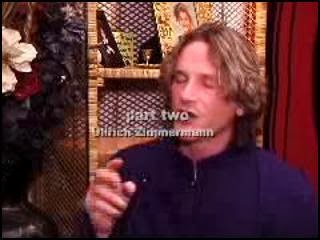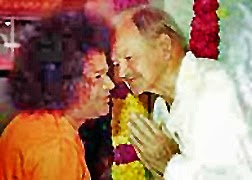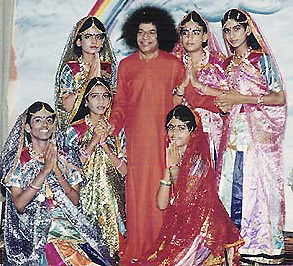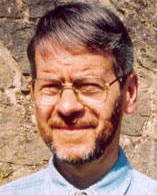 Ullrich Zimmermann
Ullrich ZimmermannIn October 2008, the Equalizer (Moreno) blog Kevin Shepherd Exposed reproduced the gist of earlier Moreno assertions about Ullrich Zimmermann. This ex-devotee had provided three lengthy online video interviews describing his relationship with Sathya Sai Baba (d.2011).
Gerald Joe Moreno (Equalizer) opted to caricature my comment that Zimmermann had contributed “one of the most arresting testimonies of sexual abuse” in relation to Sathya Sai Baba. Critics said that Moreno was desperate to distract attention from the basic issue of abuse.
Zimmermann was confused on many points by his indoctrination at an early age; he was only fourteen years old when he first contacted Sathya Sai in the ashram at Puttaparthi. An activity of sexual abuse is discernible in his reminiscences of the guru, accompanied by exaggerated references reflecting some devotee beliefs. Clinically, this sort of material is very evocative, and deemed important by psychiatrists and other specialists.
Robert Priddy composed the report Ullrich Zimmermann’s Shocking Interview with Sathya Sai Baba (2007, exbaba). Moreno countered by saying that the testimony of Zimmermann was unbelievable. The Pro-Sai campaigner invented a series of verbal diversions.
Avoiding the crux, Moreno resorted to a puerile argument that Kevin Shepherd, a “strong Anti-New Age advocate” was citing the testimony of “a New Age follower against [Sathya] Sai Baba.” I was supposed to be “giving credence to New Age beliefs.” Moreno diverted attention from the basic issue by stating that Zimmermann was “a New Age follower of Ramtha.” This theme was further twisted into the erroneous statement that I was “willing to give credence to New Age beliefs by claiming that New Age followers are intelligent, honest, credible and reliable.”
It is obvious that Zimmermann and other Western devotees were afflicted by concepts and syndromes deriving from the ‘miracle’ projection which Sathya Sai encouraged at their expense. Some of them could not think clearly in emerging from their predicament. Zimmermann expressed misapprehensions about such matters as ‘genital switch miracles,’ and became further distracted by Ramtha channelling…. The due evaluation (by Priddy) is completely ignored by Moreno, who indulges in the injurious subversion of context for which he is notorious amongst ex-devotees…. Diverse analysts have concluded that it is useless to compose responses to such a sectarian agent of misrepresentation.
Despite confusions in the reports of Zimmermann, that source does testify to sexual abuse and the common acceptance of this disparity at the Puttaparthi ashram of the guru. Zimmermann narrates a personal experience of oral sex with the guru, and says that the homosexual activities of Sathya Sai were well known to many ashram residents. Such details serve to confirm other accounts such as those of ex-devotee Conny Larsson.
In contrast, Moreno (alias Equalizer) chose the superficial and duplicit strategy of emphasising his “New Age” lore. He presented this distraction in a manner which supposedly passed the final judgment, and much to my detriment. “This information is going to be very disillusioning to Kevin Shepherd’s readers and admirers (as few as they are).”
Again the note of contemptuous dismissal. Of course, in such a Pro-Sai argument I only had a few readers, whereas Moreno was obviously claiming a much larger number, meaning devotees of Sathya Sai Baba who believed his distortions and libels. Zimmermann was only one of the many testifiers to abuse. Moreno could not stop the passage of relevant information.
Dr. [Michael] Goldstein and other officials in the [Sathya Sai] organisation are suppressing information, and attacking former devotees who have testified against Sai Baba. There is, for example, a letter from a woman in California which was sent to all [regional] Center presidents. In our center it was suppressed by the president and devotions coordinator because they were told to do so by the regional president…. Sai devotees resent the organisation being labelled a cult, yet these are clearly cult practices [of suppression] and mind control techniques.
A favoured argument of Moreno was that Sathya Sai Baba had never been convicted of any crime, therefore allegations of abuse were irrelevant. This theme is evasive and misleading, in view of contextual data concerning the compromised Indian police, the influence of prestigious devotees in Indian law courts, and reported events at the Sathya Sai Colleges.
The Indian rationalist Basava Premanand informed that a youth was murdered in 1987 after fleeing from sexual abuse. This victim was “murdered by burning in the [Sathya Sai Baba] College campus in daylight.” The contested police verdict was suicide. Other students at the College protested to the police, with the consequence that their parents were given a warning of police action against them. The Puttaparthi guru and his Trust exerted a monopoly of control over devotee jurists and bribed police officials (some of these also being devotees).
This episode has further detail in another account. The victim was Lokayya Pujari, at the village of Alike, near Mangalore in Karnataka. That village was the site of a Sathya Sai College, where Lokayya was a student. His corpse was found in charred condition. The College authorities pronounced a verdict of suicide. This explanation did not match the circumstances. Protesters mounted a hunger strike at the local police station, thereby gaining a hearing. According to the suppressed version, a College warden had hit the boy when he complained of discrepancies. He died on the spot. Kerosene was allegedly poured on the corpse to make the death look a suicide. One allegation urged that the victim here reacted to sexual abuse in the precincts (another explanation was alcohol and meat consumption). A due enquiry, conducted by Karnataka state government, was successfully offset by the Sathya Sai Central Trust based at Puttaparthi (Narendra Nayak, Investigating the Murder at Sathya Sai Baba’s College, published by Indian Skeptic, 1987, available online at exbaba.com).
Devotees were unable to believe that murders were in process. Basava Premanand suggested, in 1998, that murders occurred at Puttaparthi via the “electric crematorium of Sai Baba.” Premanand knew more about Puttaparthi than any other critic, his resistance to Sathya Sai dating back to 1968; nothing he said can easily be disregarded.
Sexual abuse of substantial extent was evidently occurring over the years at Puttaparthi and Whitefield (the second ashram, near Bangalore). An Indian student, at one of the Sathya Sai Baba Colleges, refers to a group of seniors who were themselves homosexual molesters of many boys at the hostel where he lived. More than fifty boys are here mentioned as victims. The molesters justified their paedophilia with the refrain: “Swami (Sathya Sai Baba) likes it [predatory abuse]” (Testimony from gsmprasad, 2001, exbaba, Witnesses tab). These complicit abusers were attendants in the dreaded private interview room (at Puttaparthi) where Sathya Sai molested many victims over the years. Another regular scene of abuse was the guru’s bedroom, where his giant bed suggested activities in excess of repose.
A revealing report of sexual abuse at Puttaparthi was mediated by Premanand in his Indian Skeptic journal. This described events of the 1990s and earlier. The report, in a letter dated December 1998, was composed by one of the students at Puttaparthi. Premanand accordingly wrote a letter to the Vice Chancellor of the Sathya Sai Institute of Higher Learning, requesting some investigation into the glaring improprieties. There was no reply. Premanand decided to publish the two neglected epistles in his journal.
Sathya Sai Baba with form boys dressed as gopis
The responding Indian schoolboy victims of sexual abuse were known as “form boys” and “intuition boys.” They were groomed from a young primary school age, being stripped naked by the guru in his private interview room where oral sex was the criterion for existence. “Miracle” gifts were enticements to further intimacy. If the respondents were “out of form,” chastisement could ensue. The Sathya Sai Institute of Higher Learning (at Puttaparthi) is here revealed in a less than flattering light. A senior teacher, Surendranath, is described as a pimp “who has sent countless young boys toward the cauldron for sexual molestation” in return for power and status.
“Most of the sexually molested ‘Form’ boys who have become moral and physical wrecks, leave the institution.” Education prospects were dictated by homosexual activity. If a boy did not comply with demands of the abuser, he could too easily be harassed and expelled from College. Such rejects did not wish to become “a male prostitute.” The students for “higher learning” were “forcibly being converted into homosexuals.” Some boys could no longer concentrate on their school studies because of the distractions imposed. Explicit details are provided:
[Sathya Sai] Baba thrusts his erect sexual organ in the poor boy’s mouth and asks the boy to suck and lick it and forces the boy to do so. Finally the boy is forced to suck and drink the ejaculated semen of Baba. Baba also licks and sucks the sexual organs of such boys.
At the interview room, a curtain separated these sordid encounters from general view. “One can sometimes actually see boys being molested if the curtain moves.” Moreover, “some have actually seen boys being molested with their own eyes, but keep mum [silent], for their own selfish survival, branding this dirty act as spirituality…. They [the witnesses] just act as pimps.”
Sathya Sai regularly organised holiday expeditions to certain places such as Kodaikanal, solely for the purpose of intimacy with “form boys.” These victims were even molested in the motor car and bus en route, the guru caressing their genitals in his obsessive manner. Victims were always enjoined never to talk about what happened. The “intuition boys” were often terrified of any disclosure to their uncomprehending devotee parents (who could react strongly to any suggestion of impropriety). Devotee dogma was unyielding, like the guru himself.
One of the “intuition boys” demonstrated an aberration that could occur in these circles. He himself abused about forty small innocent boys in the school system of this bizarre milieu of “higher learning.” The graphic account by the Puttaparthi student also refers to “crazy foreign ladies who are not allowed inside and are sometimes beaten up.” The guru was not partial to women, only men and boys; he is known to have made strong attempts to break up male and female partnerships. Another ominous reference is made by the student to “bodies of mostly young women which are found in the hills and also the bodies of young women which… are either burnt near Chitravathi or buried near it” (B. Premanand, Sai Baba and his Students, The Indian Skeptic, August 1999, an article also appearing online).
Kevin R. D. Shepherd
ENTRY no. 15
December 2013 (modified 2021)
Copyright © 2021 Kevin R. D. Shepherd. All Rights Reserved
 Timothy Conway
Timothy Conway

 Ullrich Zimmermann
Ullrich Zimmermann
